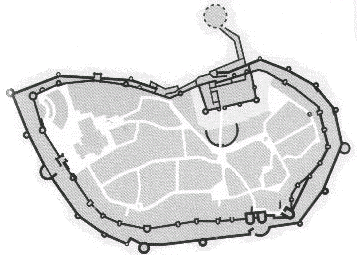The Cusader wars against the people of the Languedoc was one of sieges rather than open battles.
In a siege one army typically attacks an enemy within a stronghold. either a castle or a fortified town. Medieval towns were generally surrounded by defensive walls, just like castles. Indeed the distinction between castles and fortified towns is often blurred - in Latin, Occitan and French as in English. Castles were often located within fortified towns - in fact many towns grew up around existing castles - so that the castle became a sort of citadel within the fortified town.
|
Attackers therefore often had two sets of obstacles - first the city walls, then the castle walls. This could lead to interesting complications as at Beaucaire in 1216. For months Simon de Montfort besieged Raymondet in the town, while Raymondet besieged a garisson loyal to de Montfort in the castle within the town. Sometimes there were three sets of obstacles, because fauxburgs with their own defensive walls were often built on to the exterior of city walls, as at Carcassonne and Termes. Besiegers had a number of techniques for gaining control of their objective - either by forcing a way in, or by forcing the besieged garisson out. Specific techniques - established since prehistoric times - include: |
|
- breaching the walls or doorways. Attackers would use weapons to get through walls. Examples are stone throwing machines petriers such as trebuchets and mangonels); machines to knock holes in walls such as battering rams; and engines to extract invividual dressed stones one by one (cats, weasels and simple picks).
- tunelling under the walls. Attackers would build mines, either to gain acces to the interior or to undermine and collapse the defensive walls.
- getting over the walls. Attackers would use scaling ladders and siege engines such as large mobile wooden towers known as belfries.
- sitting and waiting. If communications between the besieged and the outside world could be cut then the defenders could be denied food supplies and sometimes water (as at Beaucaire, Carcassonne, Minerve, and Termes). This was not always possible (as for Raymondet at Beacaire and at Montsegur). The word siege means "to sit", an indication that this was a standard technique.
- A Fourth Column. Inducing someone on the inside to assist the attackers, either by bribery or exploiting divided loyalties. They could for example open a postern gate at night. Occasionally attackers could be smuggled in to the besiged fortification to fulfil this role, as for example in ancient times in the famous Trojan horse.
- Diplomacy, threats, terror and psychological techniques. To help weaken the will of the defenders, attackers could make threats or promises, or terrorise the defenders - for example by mutilating or executing hostages, or by using throwing machines to lob fire, or human heads or other body parts, into the the fortification.
- Biological Warefare. Medieval besiegers were known to project diseased animals into fortifications with the deliberate intention of spreading disease and so weakening the garisson. I some cases it was possible to poison water supplies, though most fortifications had their own wells or water cisterns.







